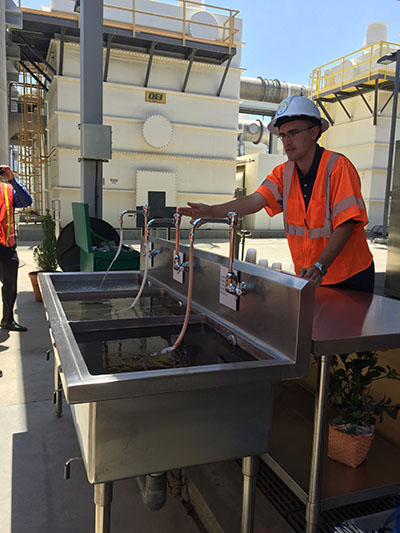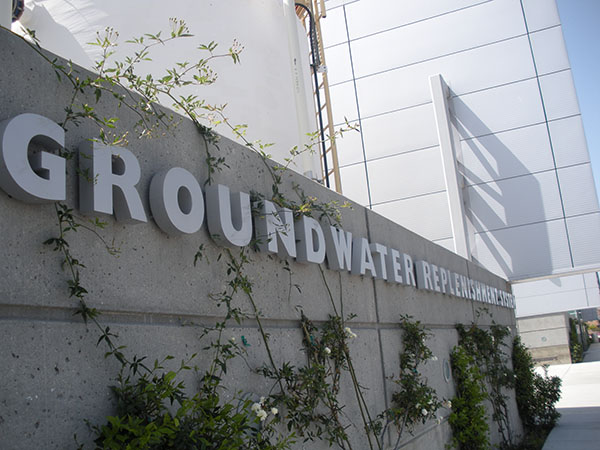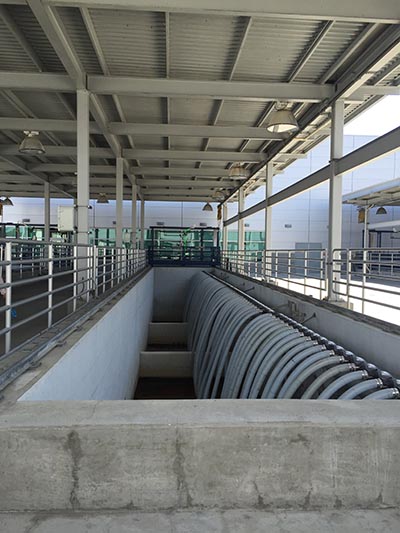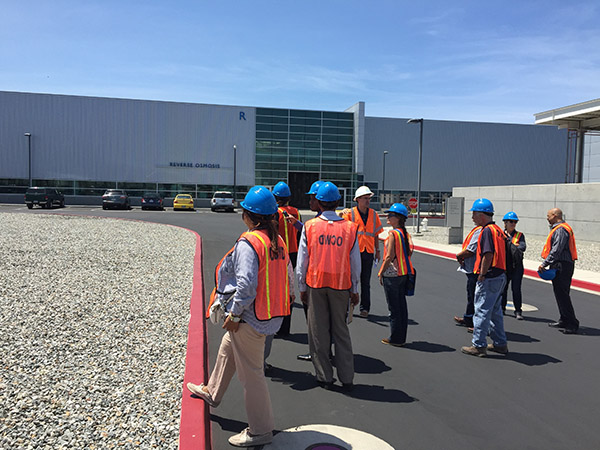Tucked away in suburban Fountain Valley, California, the Orange County Water District’s Groundwater Replenishment System (GWRS) smells vaguely of chlorine and looks like something imagined by a 1950s sci-fi writer. Sleek, shiny, and minimalist, the wastewater treatment plant feels like somewhere a robot would be very, very comfortable.
It’s also a soothing place for another kind of visitor: the Southern California water manager. My fieldwork shows these managers to be a community of expertise that likes recycled water, a steady source of supply they feel confident in their ability to treat, monitor, and deliver. “It’s here and it’s never going away, and yet most of the time we just dump it in the ocean. Reusing it just makes sense,” one 34-year veteran in the field told me with a hint of exasperation at having to state something so glaringly obvious.

Image: Pipes, pumps and filters at the Groundwater Replenishment System. Photo by author.
The aesthetic effect of the GWRS is intentional. Like the stylishly Art Deco Hoover Dam, this infrastructure is meant to be admired, built to perform both a material and a social function. Since the $481 million plant opened in 2008, the Orange County Water District has tasked it with both treating wastewater and convincing the public that drinking treated wastewater is the exciting (and safe!) wave of the future—no small feat. According to water District staff, these goals led them to design the plant—which can clean up to 100 million gallons of sewage effluent to drinking water quality each day—with the visitor experience very much in mind.
To date, thousands (including California Governor Jerry Brown) have toured the plant, following well-trained guides past long rows of gleaming pipes and fancy filters. The tours all end at an outdoor sink. There, the guide drinks first, then offers plastic cups of the newly treated water to the visitors. Afterwards, the swag—on both of my trips, reusable grocery bags stamped with the water district’s logo—is distributed, allowing the guests to take home a small piece of the experience.

Image: Our guide at the outdoor sinks, just before water sample distribution time, photo by author.
When I visited in June 2015, I learned that even the plant’s name was carefully engineered to produce a particular effect. At the suggestion of consultants, the district dropped “Orange County” from the title before they opened the plant. The consultants’ research indicated that local residents didn’t like to be reminded that their water is managed by a government entity, but did like the idea of replenishing groundwater. Keeping the focus squarely on the plant’s shiny technology was a purposeful and carefully considered choice on the part of the managers.

Image: The GWRS entrance sign, like the name, is very sharp. Photo by author.
That day, our tour group’s conversations swirled around the plant’s aesthetics. Clean lines, sharp angles—it really looked like it could be a movie set. During our pre-tour lecture, we learned that it actually had been: parts of a 2014 Johnny Depp sci fi thriller called Transcendance were filmed there. We also learned that the International Space Station relies on technology similar to the GWRS’s to turn astronauts’ urine into drinking water. Before long, talk of Frank Herbert’s bestselling novel Dune (1965) bubbled up. In the book, characters wear stillsuits—skintight bodysuits that trap and process the body’s moisture into (you guessed it) quaffable water—to help them survive on a desert planet. The GWRS, a visitor mused, is a lot like a really, really big stillsuit, a comment that evoked murmurs of assent. A quick Internet search reveals that we weren’t the first visitors to follow this train of thought. Back in 2010, a prominent design blog suggested that the plant portended a new way to think about urban hydrology—framing the city itself as a “stillsuit for surviving the drought.”
In one-on-one interviews with Southern California water managers, I’ve found them less inclined to evoke space stations and stillsuits than my tour group or guide were that day. The managers readily acknowledge the value in building sewage-to-drinking water plants that look and feel shiny enough to evoke associations with interstellar travel and Space Age techno-optimism. Back in the 1990s and early 2000s, similar projects were shelved in neighboring jurisdictions due to public outcry over the idea of consuming “toilet to tap” water. But managers much prefer to talk about recycled sewage in the stolid, unsexy terms of reliability and security. The flows from the region’s sinks, showers, washing machines, and toilets are far easier to predict and manage than those from rain, rivers, or the mountain snowpack. I’ve been told more than once that dry taps (that is, the kind stay dry even after you turn them on) are a water manager’s very worst nightmare, further underlining the appeal of a water source seen as so steady.

Image: GWRS microfiltration facilities. Photo by author.
California, as you may have heard, is currently in the midst of a severe, years-long drought. The managers’ nightmare of dry taps is a well-documented reality in some parts of the state. Recent modeling suggests that long stretches of aridity like this one, interspersed with intense periods of rainfall, will likely become the Southern California norm as the climate continues to change in the decades to come. The evidence and indicators suggest that nature isn’t a reliable supplier of water now, and will likely be even less so in the future. My water manager interlocutors frequently mention these conditions as driving factors behind their efforts to launch or expand water-recycling projects, often describing the projects as a necessary climate adaptation.
This backdrop makes the experience of the GWRS plant itself just a shade more interesting. A visit there is crafted to leave the visitor feeling confident in (and more than a little awed by) the advanced treatment technology used to cleanse the water. Yet for all the techno-optimistic evocations of rockets and progress on such a tour, in the minds of those who manage it, the plant exists in the service of far more modest aims. This is infrastructure meant to buffer an already-existing megalopolis from an increasingly inhospitable climate, a grab for predictability and stasis under conditions of accelerating uncertainty.

Image: A tour group heading towards the GWRS reverse osmosis facilities. Photo by author.
Sayd Randle is a doctoral candidate in environmental anthropology at Yale University. Her work focuses on the politics of urban ecosystem services and water infrastructure.

1 Trackback